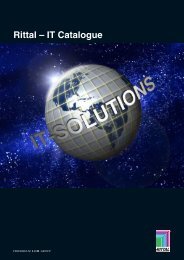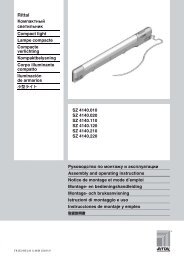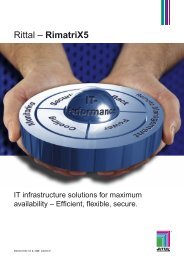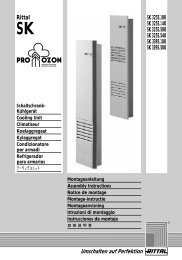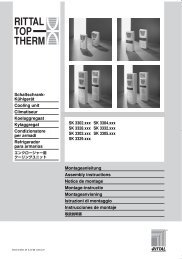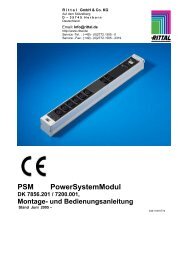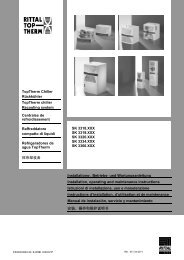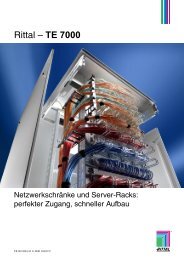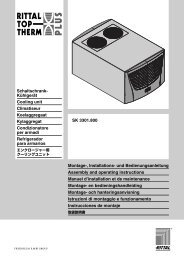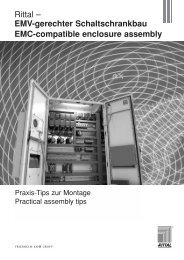Instructions - Rittal
Instructions - Rittal
Instructions - Rittal
You also want an ePaper? Increase the reach of your titles
YUMPU automatically turns print PDFs into web optimized ePapers that Google loves.
8.2 Water quality<br />
In case of cooling of/with water + glycol or similar<br />
fluids in the open circuit, always observe the following<br />
points:<br />
Regularly clean solid residues (from any filters<br />
used),<br />
Algae and deposits, as well as<br />
Corrosion,<br />
can cause damage to the recooling unit. Residues<br />
will always impair the performance of the recooling<br />
unit. Without water treatment it is seldom possible to<br />
achieve satisfactory conditions. By means of regular<br />
monitoring of the quality of the cooling medium and<br />
cooling medium treatment, you must ensure that<br />
deposits and corrosion are avoided, even under<br />
extreme conditions.<br />
There are specific cooling medium requirements<br />
depending on the type of equipment being cooled. A<br />
suitable process must then be used to prepare<br />
and/or maintain the cooling medium to suit the level<br />
of contamination and the size and design of the<br />
recooling system. The most common types of contamination<br />
and most frequently used techniques to<br />
eliminate them in industrial cooling are:<br />
Mechanical contamination:<br />
Filtering of the cooling medium via mesh filter,<br />
gravel filter, cartridge filter, or pre-coated filter<br />
Excessive hardness:<br />
Softening of the cooling medium using ion exchange<br />
Moderate content of mechanical contaminants<br />
and hardeners:<br />
Addition of stabilisers and/or dispersing agents to<br />
the water<br />
Moderate content of chemical contaminants:<br />
Addition of passifiers and/or inhibitors to the cooling<br />
medium<br />
Biological contaminants, slime bacteria, and<br />
algae:<br />
Addition of biocides to the cooling medium<br />
Note!<br />
The cooling medium thickens due to<br />
evaporation. You can return the values<br />
to within the usual ranges by completely<br />
replacing the cooling medium. Only use<br />
distilled or de-ionised water in recooling<br />
units specified for such use (see chapter<br />
11).<br />
The manufacturer's guarantee and liability will be<br />
rendered void in cases of incorrect use and treatment<br />
of the recooling unit.<br />
To prevent problems in the coolant/heat transfer<br />
circuit (also on water-cooled units), it is imperative<br />
that the VEB Cooling Water Guidelines (VGB-R<br />
455 P) are observed (for source, see chapter 12).<br />
Portion of antifreeze in the cooling medium, see<br />
chapter 11.<br />
8 Inspection and maintenance<br />
The cooling medium and/or cold water must not<br />
cause any limescale deposits or loose debris.<br />
In other words, it should have a low level of hardness,<br />
particularly a low level of calcium hardness. In<br />
particular, the level of calcium hardness should not<br />
be too high when using the equipment for recirculated<br />
cooling. On the other hand, the cooling medium<br />
should not be so soft that it attacks the materials.<br />
When recooling the cooling medium, the salt<br />
content should not be allowed to increase excessively<br />
due to the evaporation of large quantities of<br />
water, since the electrical conductivity will increase<br />
as the concentration of dissolved substances rises,<br />
and the cooling medium will become more corrosive.<br />
For this reason, not only is it always necessary<br />
to add a corresponding quantity of fresh water, but<br />
also to remove part of the enriched cooling medium.<br />
Hydrological data<br />
The properties of the water used should not deviate<br />
from the hydrological data listed below.<br />
The local drinking water values are to be noted.<br />
Properties Value<br />
pH value (7) 7.5 – 8.5<br />
Elec. conductivity 200 – 1000 µS/cm<br />
Residue on<br />
< 500 mg/dm³<br />
evaporation<br />
Sedimentary<br />
< 3 mg/dm³<br />
substances<br />
Hardness 3 – 8°dH (for German-speaking<br />
region)<br />
Ca + Mg 0.5 – 2 mmol/l (for<br />
international region)<br />
Hydrogen carbonate 1 – 5 mmol/dm³<br />
(60 – 300 mg/dm³)<br />
Free CO2<br />
< 10 mg/dm³<br />
Sulphide < 0.01 mg/dm³<br />
Chloride < 50 mg/dm³<br />
Sulphate < 250 mg/dm³<br />
Nitrate < 25 mg/dm³<br />
Nitrite < 0.1 mg/m³<br />
COD < 7 mg/dm³<br />
NH4<br />
< 0.05 mg/dm³<br />
FE < 0.1 mg/dm³<br />
Mn < 0.1 mg/dm³<br />
Cu < 0.1 mg/dm³<br />
Tab. 6 Hydrological data<br />
Page 30 of 61<br />
EN



